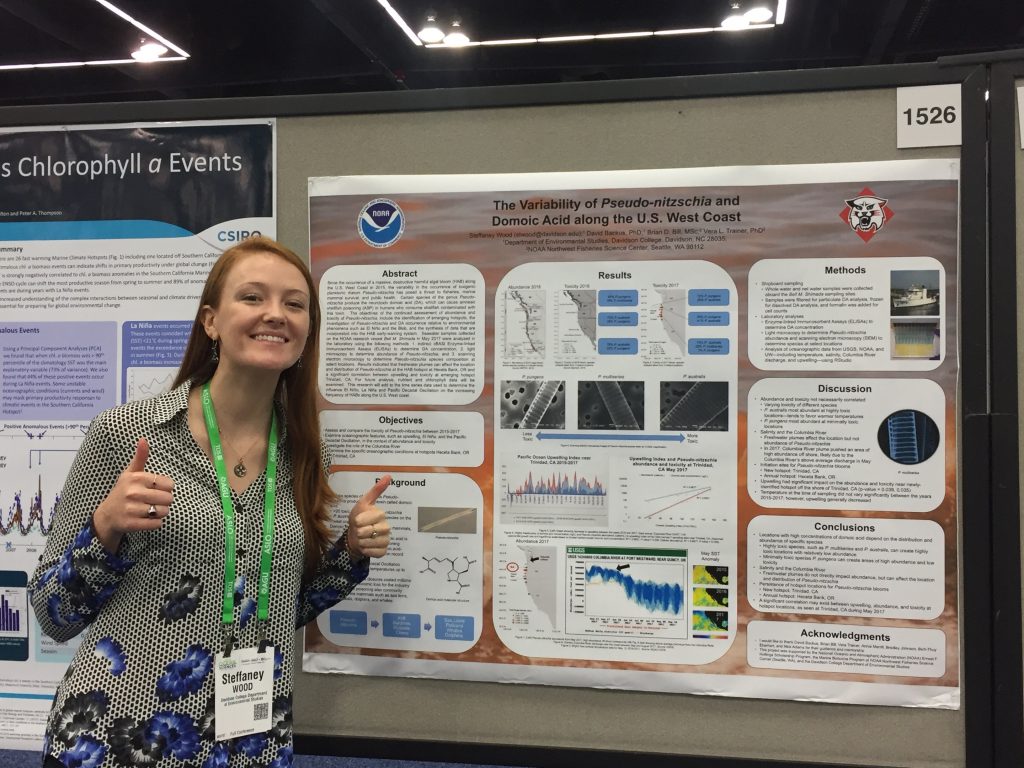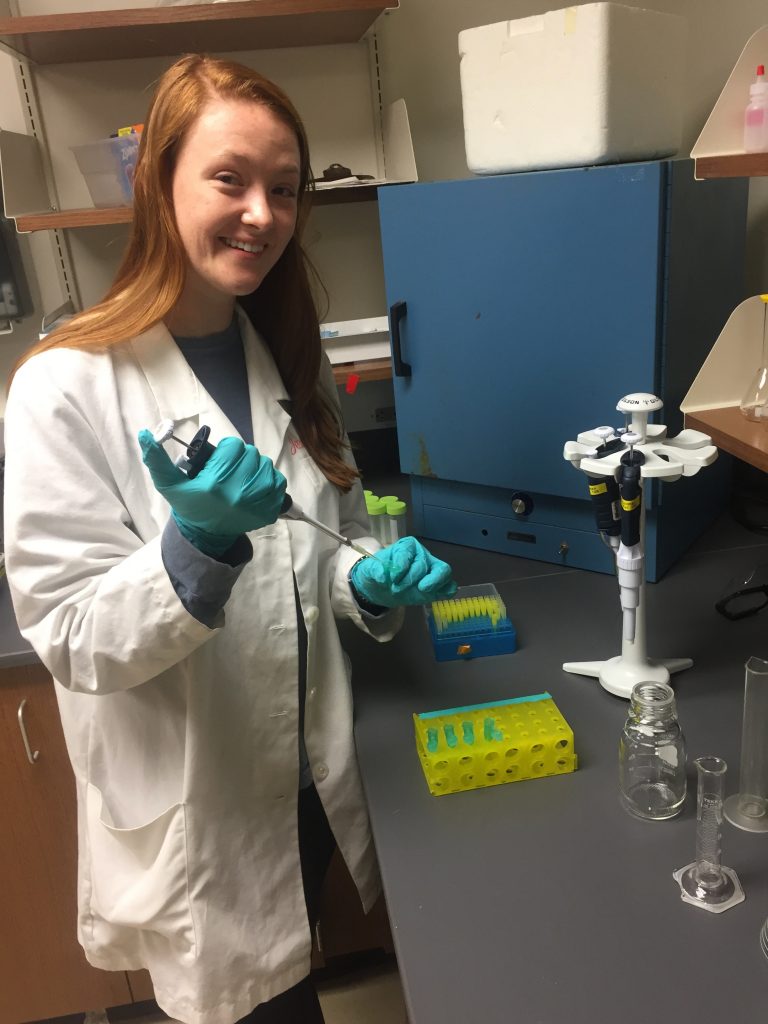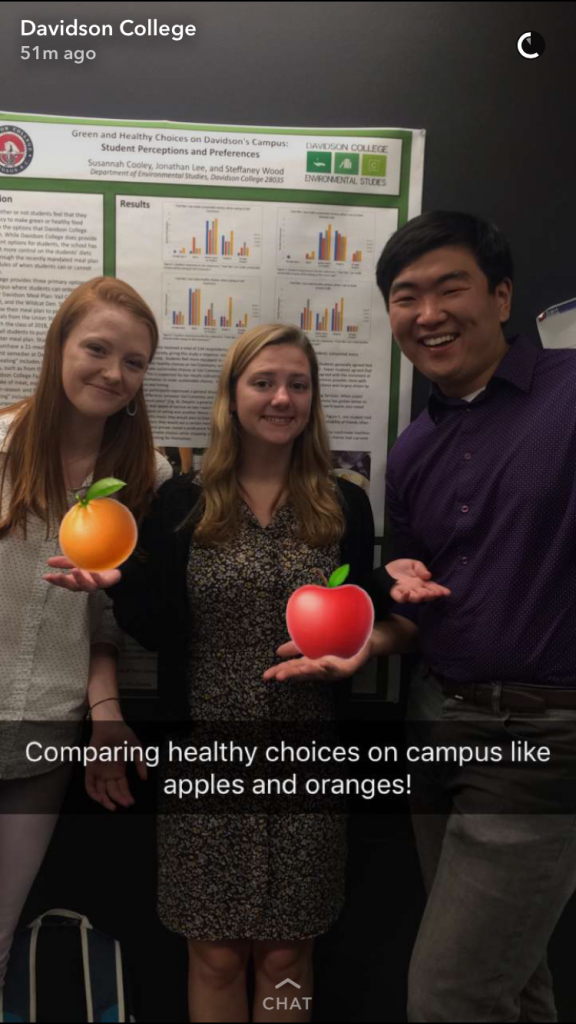Research
NOAA Hollings Scholar Project and Environmental Studies Capstone Project

ABSTRACT: Since the occurrence of a massive, destructive harmful algal bloom (HAB) along the U.S. West Coast in 2015, the variability in the occurrence of toxigenic planktonic diatom Pseudo-nitzschia has posed a threat to fisheries, marine mammal survival, and public health. Certain species of the genus Pseudo-nitzschia produce the neurotoxin domoic acid (DA), which can cause amnesic shellfish poisoning (ASP) in humans who consume shellfish contaminated with this toxin. The objectives of the continued assessment of abundance and toxicity of Pseudo-nitzschia, include the identification of emerging hotspots, the investigation of Pseudo-nitzschia and DA occurrence relative to environmental phenomena such as El Niño and the Blob, and the synthesis of data that are incorporated into the HAB early-warning system. Seawater samples collected on the NOAA research vessel Bell M. Shimada in May 2017 were analyzed in the laboratory using the following methods: 1. indirect cBASI Enzyme-linked Immunosorbent Assays (ELISAs) to determine DA concentration; 2. light microscopy to determine abundance of Pseudo-nitzschia; and 3. scanning electron microscopy to determine Pseudo-nitzschia species composition at select locations. Available data from 2015-17 was analyzed using RStudio. Results indicated the existence of emerging HAB hotspot off the coast of Trinidad, CA and that freshwater plumes can affect the location of Pseudo-nitzschia at the HAB hotspot Heceta Bank, OR. For future analysis, nutrient and chlorophyll data will be examined. This research will add to the time series data used to determine the influence El Niño, La Niña and Pacific Decadal Oscillation on the increasing frequency of HABs along the U.S. West coast.
See poster: Capstone Poster-WOOD
See abstract for American Geophysical Union Fall Meeting 2017: https://agu.confex.com/agu/fm17/meetingapp.cgi/Paper/300829
See abstract for Ocean Sciences Meeting 2018: https://agu.confex.com/agu/os18/meetingapp.cgi/Paper/320965
See more Capstone related content: http://www.steffaneywood.com/capstone/
Please email steffaney.wood@gmail.com for a copy of the full report.
DTT Assay: Hookah Smoke Toxicology

ABSTRACT: Waterpipe and Hookah cafés are becoming popular worldwide despite significant epidemiological evidence associating waterpipe tobacco smoke (WTS) and airborne particulate matter (PM) with negative health effects. Many studies have found that the harmful health effects of PM (e.g. atmospheric aerosols, urban PM2.5, and diesel exhaust) result from oxidative stress prompted by the formation of reactive oxygen species (ROS) within affected cells. The elevated concentrations of ROS in the cell can cause inflammation and apoptosis. The acellular dithiothreitol (DTT) assay has been used to measure the ROS of a variety of particles; however, no studies to date have used this DTT assay method to characterize and quantify the ROS in WTS. To address this knowledge gap, the objectives of this project included identifying the ideal methods for the assay and determining the initial efficacy and viability of the DTT assay for future WTS research. To address these objectives, positive control phenanthrenequinone (PQN) and WTS PM samples were analyzed using UV-Vis spectroscopy, determining the concentration of DTT, and plotting the DTT concentration as a function of time to determine the rate of loss. Results indicated that the assay is accurate and reproducible due to the consistency of the blank and positive control samples. Additionally, PQN was confirmed to be an appropriate positive control. Comparing the concentration-dependent rates of DTT loss among PQN and WTS PM samples show that PQN has higher oxidation potential, which indicates that PQN has greater relative concentration of ROS than the selected WTS PM samples. For future analysis, the assay will be conducted using a 96-well plate measuring the ROS of Teflon syrup, charcoal, and other varieties of Shisha.
Please email steffaney.wood@gmail.com for a copy of the poster or full report.
Uncovering Student Perceptions of Green and Healthy Food Options and Davidson Dining Services

ABSTRACT: Through this project, our group attempted to uncover whether or not Davidson students feel that they have agency to make green or healthy food choices within the Davidson College food system. In order to do so, we sent out a survey to 100 random students in each year to gauge general understandings and impressions of Davidson Dining Services. In our survey, we addressed primarily addressed the topics of cooking and eating habits. In addition, we also found 12 volunteers to participate in a photo-based focus group discussion. Participants were asked to take photos of food, places, and people involved within their “Davidson food ecosystem” and then discussed those experiences in a focus-group environment. Based on initial results, personal experiences, and student-held discussions on campus, we expect to find a general dissatisfaction with Davidson Dining Services in its provision of green and/or healthy food choices to students. We hope to share these findings with Davidson Dining Services so that the school can be better equipped to make knowledgeable decisions about where and what Davidson students eat on campus.
See poster: http://alendalux.davidson.edu/